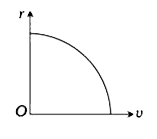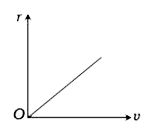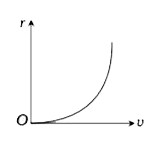A particle of mass m moves in a circular orbit under the central potential field, U(r)==−Cr, where C is a positive constant.
The correct radius -velocity graph of the particle's motion is.




The correct Answer is:D
F(x)=∂U∂r=Cr2
v=√Cm
v∝1r1/2
Similar Questions
A particle of mass m is moving in a horizontal circle of radius r under a centripetal force equal to -a//r^(2) , where a is a constant. What is the total energy of the particle ?
View Solutiona particle moving in a circle track is given potential energy U=−kr where U is potential energy and r is radius. The correct graph between speed and radius of particles will be
View Solutionद्रव्यमान 'm' का कोई कण वृत्तीय कक्षा में, केन्द्रीय विभव क्षेत्र U(r)=−Cr के अधीन गति करता है। यहाँ C एक धनात्मक स्थिरांक है। इस कण की गति के लिए त्रिज्या-वेग का सही ग्राफ होगा :
View SolutionA particle of mass m moves in a circular orbit under the central potential field, U(r)==−Cr, where C is a positive constant.
The correct radius -velocity graph of the particle's motion is.
View SolutionA particle of mass m moves in a circular orbit in a central potential field U(r )=U_(0)r^(4) . If Bohr's quantization conditions are applied, radü of possible orbitals r_(n) vary with n^((1)/(alpha)) , where alpha is _________.
View SolutionA body moves in a circular orbit of radius R under the action of a central force. Potential due to the central force is given by V(r) = kr (k is a positive constant). Period of revolution of the body is proportional to-
View SolutionThe potential energy U of a particle in a field varies with position r as U=ar2−br
where a and b are positive constants. Find the positions, where the particle:will be in stable equilibrium.
View SolutionA body moves in a circular orbit of radius R under the action of a central force. Potential due to the central force is given by V(r) = kr (k is a positive constant). Period of revolution of the body is proportional to-
View Solution